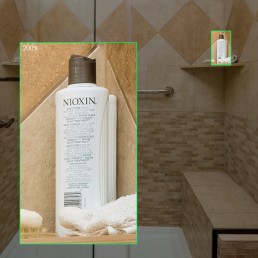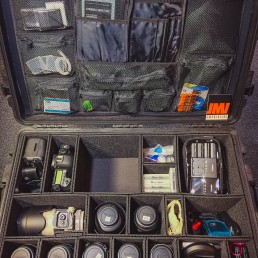Every year or so I get the itch to upgrade or change around my gear selection. After some recent changes and additions, here we go…
CASE
Right now, I’m rocking a Pelican 1650 case that I’ve outfitted with the TrekPak insert system. I can’t find the words to tell you how awesome the TrekPak system is! No more incessant ripping of velcro strips. TrekPak’s premise is that it uses closed-cell rigid foam dividers that each have a corrugated strip down the center.
The kit includes a 2-piece outer surround that fit my Pelican 1650 inside perfectly. The kit also includes several long divider panels (depending on the exact kit/case), a special handheld cutter that fits into those corrugated holes, and a set of pins. The cutter follows those corrugated channels and makes it impossible to make a crooked cut. After you’ve made your cut for a compartment divider, you take the heavy-duty metal pins and “pin” the panels together. It’s infinitely configurable and super easy. The hardest part is strategizing on how you want to lay your gear out within the case before you start cutting panels. I ended up purchasing an extra divider piece, two extra sets of pins, and some of TrekPak’s foam lens blocks. With the tall interior height of the Pelican 1650, TrekPak recommends pinning the dividers from the top and the bottom so that nothing moves. In testing it out, I’m not sure this is essential (it also doubles the number of pins you need), but it definitely can’t hurt.
CAMERAS
I have recently added the Canon 5DSR to my stable. The 5DSR packs a whopping 50 megapixels, which more than doubles the resolution my previous body, the 5D Mark III. I haven’t put the 5DSR through many paces yet, but it’s almost exactly the same as the 5D III in-hand. The mirror flip-up has a different sound (due to the redesigned mechanics to reduce mirror-induced vibration), and there are some minor menu changes. The real difference only becomes apparent long after the shoot when you are processing the files. I was recently shooting a residential interior, and shot the image below of a shower. In that shower is a bottle of shampoo on a shelf. Zoom into that image at 200%, and you can read the ingredients list on the bottle. That’s mighty impressive!
I continue to kick myself for selling off the Phase One P30+ medium format setup I had back in 2009. Someday, I’ll get back into medium format. For now, I have 50 megapixels and the sharpest Canon lenses I could find.
LENSES
Everyone knows (or should know) that glass is where the real investment is. Camera bodies are largely replaceable and upgradeable. Lenses are the real meat of a photographer’s kit. That said, whenever I buy a new lens, I actually buy two (sometimes three) of them and side-by-side test each. All lenses are not created equal, and in fact I’ve witnessed fairly significant performance differences between multiple copies of the same lens. I can at least rest easy knowing I got at least reasonably “sharp” copy of a particular lens.
Here’s my current lens list:
- Canon 14mm 2.8L
- Canon 24mm 3.5L TS-E
- Canon 35mm 1.4L II
- Canon 85mm 1.2L II
- Canon 100mm 2.8L IS Macro
- Canon 24-70mm 2.8L II
- Canon 70-200mm 2.8L II IS
- Canon 1.4x II Teleconverter
- Dog Schidt Optiks FF58
ACCESSORIES
Notable accessories include:
- Two Gitzo carbon fiber tripods. One is a lighter-weight travel tripod with a RRS BH-55 ballhead on it. The other is a beefy set of legs from Gitzo’s Systematic collection. This is my main tripod, and it sports the amazing Arca Swiss Cube geared head.
- Pro P TS-E adapter, which is basically a tripod collar for the 24mm TS-E. This allows you to keep the lens stationary while doing shift movements for completely seamless multi-shot panoramas.
- Circular polarizers and UV filters for each lens size, and one adjustable polarizer.
- A whole assortment of 64GB – 8GB memory cards.
LIGHTING
The lighting gear is too numerous to mention beyond the big pieces. I have all manner of grip including scrims, diffusion material, umbrellas, soft boxes, strip boxes, a boom, C-stands, fold up stands, clamps, a beauty dish, grids, collapsible reflectors, etc.
The main gear includes:
- (6) Paul C Buff Einstein 640ws strobes
- (3) PCB Vagabond Litium Extreme battery packs for location shoots
- (6) Canon 600EX-RT speedlights
- Wireless controls and triggers for both systems
There’s tons more little things I glossed over, but you get the idea. Shooting studio still-life and interior architecture are two of the most technical and specialized photography fields there are. That’s why I love them!

